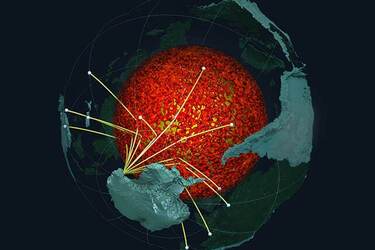Scientists have found the bottom of an ancient ocean at a depth of more than 3000 km, it could have enveloped the Earth's core

A team of scientists has made a detailed high-resolution map of the geology of the southern hemisphere of the Earth and found a previously unknown phenomenon: the floor of an ancient ocean, which may be located around the planet's core.
This thin but dense layer is about 2,900 km below the surface, where the molten metallic outer core meets the rocky mantle. This core-mantle boundary plays an important role in the study of volcanic eruptions and changes in the Earth's magnetic field.
Read also: Archaeologists discovered a Mayan scoreboard, which they used to play ball
To create this map, scientists used data from 15 monitoring stations located in Antarctica, which collected seismic waves from earthquakes for three years. Analysis of these waves allowed scientists to identify thin, anomalous zones of material at the boundary between Earth's core and mantle, where sound waves travel more slowly, and these zones are called ultra-low-velocity zones (ULVZs). The thickness of the material in these zones ranges from several to tens of kilometers, which indicates the presence of mountains in the Earth's core in some places.
"Our research provides the highest resolution image of the internal structure of our planet, and we find that this structure is much more complex than previously thought," explains geologist Samantha Hansen from the University of Alabama.
According to the researchers, these so-called "ULVZ" (Ultra Low-Velocity Zones) are probably hidden oceanic crusts that formed millions of years ago. Even if this sunken crust is not near known subduction zones on the surface, where the movement of tectonic plates pushes rock deep into the Earth, the simulations cited in the study show how convection currents can shift the floor of an ancient ocean to its current resting place.
Read also: Archaeologists discovered a thousand-year-old settlement in the Dominican Republic
Although it is difficult to draw precise conclusions about rock types and movement based on the movement of seismic waves, researchers believe that the oceanic crust hypothesis is the most likely explanation for these "ULVZs" at present.
There is also speculation that this ancient oceanic crust may surround the entire Earth's core, although this is difficult to confirm due to its thinness. Future seismic research will further help clarify the overall picture.
"Our research establishes important connections between the shallow and deep structure of the Earth and the general processes that drive our planet," Hansen says.
We will remind you that earlier we wrote that scientists found evidence of double mass extinctions on Earth.
If you want to receive the latest news about the war and events in Ukraine, subscribe to our Telegram channel!
